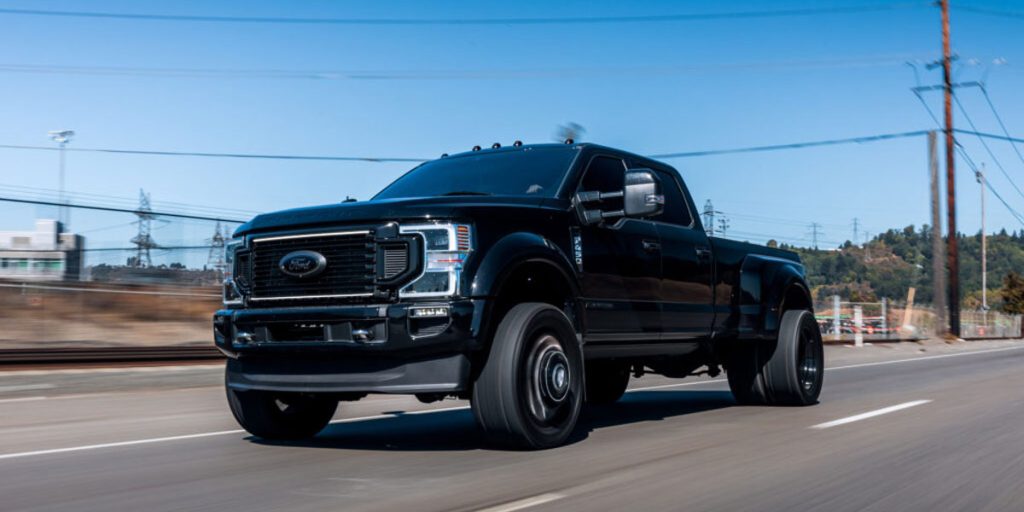A typical dually truck weighs between 6,000 to 8,000 pounds. The exact weight depends on the make, model, and configuration of the truck.
Dually trucks, known for their dual rear wheels, hold a revered spot in the heavy-duty truck category, offering enhanced stability and towing capacity.
These powerhouses cater to rigorous demands, efficiently hauling large trailers, campers, or carrying heavy loads.
The additional weight and robust design translate to superior road grip and performance in challenging conditions.
Their substantial curb weight underscores a structure engineered for endurance and reliability.
Ideal for both commercial and personal use, dually trucks are the go-to vehicles for those requiring high towing capabilities without sacrificing control or safety.
As a pivotal element in the automotive world, understanding a dually’s weight is essential for compliance with towing laws and regulations, ensuring safe and efficient operations.
What Is A Dually?
A dually stands out on the road. Not just for its size, but for its distinct feature: dual rear wheels on each side.
Trucks with this setup have a total of six wheels: four in the back and two in the front. This design improves stability, towing capacity, and payload capabilities.
Now, let’s explore the functionality and common uses of these powerful vehicles.
Dual Rear Wheels Functionality
Dually trucks have a clear purpose: enhanced performance under heavy loads. With two wheels on each side at the rear, weight distribution improves significantly.
This leads to better traction, especially when hauling large trailers or carrying heavy loads.
The dual-wheel system also contributes to safer handling, reducing the risk of blowouts and providing more stability during high winds or abrupt maneuvers.
Common Uses For Dually Trucks
- Commercial Hauling: Businesses rely on dually trucks to transport goods safely and efficiently.
- Recreation: They are ideal for towing recreational vehicles, such as boats or large campers.
- Agriculture: Farmers appreciate the ability to carry hefty loads like livestock or produce.
- Construction: Duallys are a go-to choice for moving heavy materials or machinery.
Dually Weight Factors

Understanding the weight of a dually truck is crucial for various reasons. Whether towing heavy loads or considering fuel efficiency, the weight plays a key role.
Several factors contribute to the overall weight of a dually. These include the base curb weight and the weight of additional features that may be added to the truck.
Let’s delve into what affects a dually’s weight.
Base Curb Weight Explained
The base curb weight of a dually refers to the truck’s weight including standard equipment but without passengers or cargo.
It’s the weight of the truck as it leaves the factory floor. This number is important because it is the starting point for understanding the vehicle’s weight.
The base curb weight can change based on:
- Engine size
- Drivetrain type
- Cab and bed length
Impact Of Additional Features On Weight
Adding features to a dually increases its weight. These features might enhance performance, safety, or comfort. It’s vital to consider this when calculating the truck’s total weight.
Common features that add weight include:
| Feature | Weight Increase |
|---|---|
| Towing package | 50-250 lbs |
| 4WD system | 150-400 lbs |
| Heavy-duty suspension | 100-300 lbs |
| Luxury interior options | 50-200 lbs |
Towing Capacity And Weight Relationship

The power to haul heavy loads is crucial for dually trucks, known for their twin rear wheels.
Understanding the relationship between towing capacity and the truck’s weight is key.
It’s about balance: too heavy a truck has its drawbacks, while too light might not cut it for tough jobs.
Below we explore how weight impacts towing ability and ways to maximize towing efficiency.
How Weight Affects Towing Ability?
Consider the heft of a dually when it has a load hitched to it. The truck’s weight is vital for control and stability. Here’s the breakdown:
- Heavier trucks grip the road better, essential when towing.
- Extra weight adds stress to the engine and brakes.
- A stable weight ensures that the trailer doesn’t sway, keeping your cargo safe and secure.
The magic number lies in a dually’s Gross Combined Weight Rating (GCWR). It tells you the maximum weight of both the truck and its trailer.
Stay within this limit for the safest towing experience.
Maximizing Towing Efficiency
Balancing the scale between truck weight and towing capacity allows for peak performance. Here’s how to maximize towing efficiency:
- Check your dually’s specs: Know your vehicle’s GCWR for the best match with your trailer.
- Distribute weight evenly: This ensures stability and prevents strain on any one part.
- Regular maintenance: Keep your truck in top shape to prevent any hiccups on the road.
Implement these steps to make certain each haul is smooth, stable, and secure.
Weighing A Dually Truck
Knowing the weight of a dually truck is important. For instance, it can affect fuel efficiency and how much you can haul.
It is also crucial for staying within legal limits. Here we will discuss how to measure a dually’s weight correctly and the regulations for road weight limits.
Methods For Accurate Weight Measurement
Finding the exact weight of a dually truck can be done in multiple ways:
- Truck Scales: These are large scales that can handle heavy-duty trucks.
- Portable Wheel Weighers: Convenient and easy to use, they can weigh each wheel separately.
- On-board Weighing Systems: Installed on the truck, they provide continuous weight data.
| Method | Description | Pros | Cons |
|---|---|---|---|
| Truck Scales | Permanent scales at locations like truck stops. | High accuracy | Not always nearby |
| Portable Weighers | Small scales for individual tires. | Easy to move | May need multiple readings |
| On-board Systems | Built into the truck’s systems. | Real-time info | Initial installation cost |
Each method will have pros and cons, but accuracy is key. Make sure to use certified scales for legal purposes.
Legal Weight Limits On Roads
Every state has its own weight limits. Exceeding these limits can lead to fines.
- Single Axle: Generally limited to about 20,000 pounds.
- Tandem Axle: A double axle has a higher limit, usually around 34,000 pounds.
- Gross Vehicle Weight: The total limit for a vehicle, often capped at 80,000 pounds without special permits.
Always check state regulations before hauling heavy loads. This ensures safety and avoids penalties. Keep in mind that some local roads may have stricter rules than highways.
A dually truck is often heavier than single rear wheel pickups. But its weight still must comply with these limits. Plan your load according to your truck’s specs and legal weight standards.
Maintenance For Peak Performance
Knowing the weight of your dually truck is just the start. To keep your heavy-duty vehicle running smoothly, regular maintenance is key.
This not only ensures your dually’s longevity but also its safe operation. Let’s delve into the practices that help manage the weight and impact of upgrades on your truck.
Regular Check-ups For Weight Management
Staying on top of your dually’s weight is crucial. It’s important for safety and efficiency.
Over time, trucks can gain weight from added accessories or cargo build-up. Regular check-ups let you catch these changes:
- Tire pressure: Proper inflation can affect weight distribution.
- Brake systems: Ensure they are not adding unnecessary weight.
- Fluid levels: Excess fluids can add weight; keep them in check.
Use a certified weigh station to measure your dually periodically. This helps maintain optimal weight ranges for peak performance.
Upgrades And Modifications Impact On Weight
Upgrades can improve your dually’s functionality, but they also affect weight. Consider these factors before modifying your vehicle:
| Upgrade | Weight Impact |
|---|---|
| Heavy-duty bumpers | Can add significant weight |
| Toolboxes | Extra weight depends on size and material |
| Additional seating | More seats equal more pounds |
Every addition has an impact. Account for these changes to stay within your truck’s safe weight limits.
Remember to balance the modifications with the vehicle’s overall weight capacity to keep your dually in top form.
Comparing Dually Weights
Dually trucks, known for their wide stance and dual rear wheels,
are workhorses in the world of heavy lifting and towing. But how much does a dually
actually weigh?
It’s not just a question of numbers; the weight of a dually can vary significantly. This is due to a range of factors including brand, model, and the specific configurations of the vehicle.
Differences Across Brands And Models
Every truck brand brings something unique to the table, including their approach
to dually design.
For instance, a Ford F-350 might not weigh the same as a Chevrolet Silverado 3500HD. To give you a clear picture, here’s a look at how these weights can differ:
- Ford: Known for its high-strength, military-grade aluminum bodies.
- Chevrolet: Often features a mix of aluminum and steel for a sturdy build.
- Ram: May offer heavier curb weights due to robust steel frames.
Even within the same brand, different models and options can change the weight.
Engine choices, bed lengths, and cab configurations all play a role.
Average Weight Ranges For Popular Duallys
Let’s zero in on the average weights of some popular dually trucks on the market.
This will give you a ballpark figure to work with:
| Truck Model | Average Weight |
|---|---|
| Ford F-350 | 7,500-8,500 lbs |
| Chevrolet Silverado 3500HD | 6,600-7,700 lbs |
| Ram 3500 | 7,300-8,600 lbs |
These weights are often for base models before any customizations or additional features are added.
FAQ About the Weight of a Dually
What Is The Average Weight Of A Dually?
A typical dually, which is a pickup truck with dual rear wheels, can weigh between 7,000 to 8,000 pounds.
However, this weight can significantly vary depending on the make, model, and customizations.
How Does A Dually’s Weight Affect Towing Capacity?
A dually’s heavier weight contributes to its stability and towing capacity.
It generally allows for a higher towing limit due to the increased traction and control from the dual rear wheels, which can be essential for hauling large trailers or campers.
What Are The Benefits Of A Heavier Dually Truck?
Heavier dually trucks offer enhanced stability, especially under load and during towing.
They provide better traction and can handle rougher terrain with ease, which is advantageous for commercial hauling or when navigating difficult work sites.
Can The Weight Of A Dually Impact Fuel Economy?
Yes, the weight of a dually can negatively impact fuel economy.
The additional weight from the dual rear wheels increases resistance, which can lead to higher fuel consumption, especially during towing or when driving on highways.
Conclusion
Understanding the weight of a dually is crucial for safety and legal compliance. As we’ve explored, the weight varies based on model and modifications.
Always check manufacturer specs and weigh your vehicle if in doubt. Proper knowledge ensures you’re well-equipped for the road.
Drive confidently, knowing your dually’s weight.
Resources:
https://www.badgertruck.com/heavy-truck-information/what-is-a-dually-truck/
